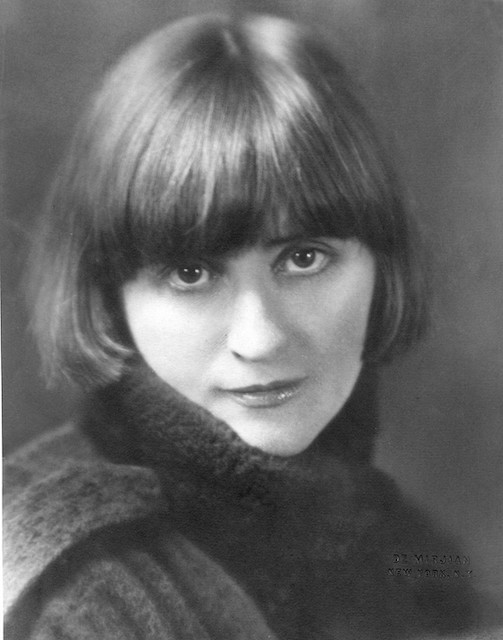
Dixie Willson, around 1925. Photo courtesy of Mason City Public Library Historical Collection
Jan/Feb 2023 (Volume 15, Issue 1)
By Leo Landis
In what would be a harbinger of future success, the Mason City Globe-Gazette of Feb. 17, 1914, reported that a crowd packed the Cecil Theatre to see Dixie Willson’s “clever, delightful, musical comedy,” “The Blue Heron.”
Willson is largely forgotten today, but by 1935 she earned national celebrity for screenwriting, books and magazine articles. Her stature waned through the 1950s when she felt that work she had produced with her famous brother, Meredith Willson, did not receive proper recognition.
Born Lucille Reineger Willson on July 30, 1890, in Estherville, Dixie was the oldest child of Rosalie (a primary school teacher and piano tutor) and John David Willson (a lawyer). The Willson family moved to Mason City in 1894 where Dixie’s two brothers were born, John Cedric Willson and Robert Meredith Willson. It was in Mason City where Dixie started her writing career as a young girl and demonstrated creativity and productivity in multiple fields. Among her first efforts were short poems published in newspapers and national magazines through the 1920s. She also had four film credits, including “The Age of Desire” (1923), “God Gave Me Twenty Cents” (1926), “An Affair of the Follies” (1927) and “3-Ring Marriage” (1928). The New York Times asserted in 1926 that “in the last eight years Miss Dixie Willson, authoress of ‘God Gave Me Twenty Cents,’ has accomplished more than most writers do in a lifetime.”
Her children’s book “Honey Bear” (1923) was illustrated by Maginel Wright Barney, who also understood life with a famous brother, the architect Frank Lloyd Wright. Decades later, in 2003, the author Tom Wolfe told Yale University’s alumni magazine that even as a boy her book made him “think writing must be not only magical but fun. It isn’t, particularly, but ‘Honey Bear’ was fun, and [he] resolved then and there, lying illiterate on a little pillow in a tiny bed, to be a writer.” As a tribute, Wolfe worked references to “Honey Bear” into all his novels.
Willson received prominent writing assignments. She interviewed notables ranging from child superstar Shirley Temple to Walt Disney to the suffrage leader Carrie Chapman Catt, and her popularity and productivity continued into the 1930s. She also chronicled the daily operations of fellow Iowans the Ringling Brothers (who were born and spent their formative years in McGregor from 1960 to 1872) and Barnum and Bailey Circus in her 1932 book “Where the World Folds Up at Night.”
Regrettably, her relationship with her brother soured. While historians disagree, some evidence indicates Dixie Willson had begun writing a play titled “The Silver Triangle” about Mason City. She had expressed an interest in writing a story about the city where she grew up, and a 1936 feature in the Globe-Gazette mentioned that “she really does have a plan for one just as her brother, Meredith … plans to write a Mason City symphony.”
Dixie Willson claimed that her own writing formed the framework for “The Music Man,” the famous musical attributed to her brother. In a copy of a letter held both at the University of Iowa and the Mason City Public Library, Dixie Willson repeatedly notes that she had done much of the work herself. She asserts the plan was to have a production done by the sister-brother team and was stunned to see him produce a manuscript that was a “Play by Meredith Willson.” She felt wronged and believed the work was at least half hers.
Meredith Willson never acknowledged her contributions, and it’s possible “The Music Man” may be entirely his. However, Dixie Willson had expressed a plan to create such a play and had significantly more experience in writing for the stage. She gave him credit for his efforts, but she wanted her own recognition, too.
In the late 1950s, Dixie Willson moved to New Jersey and remained active in her community of Fair Haven. Perhaps she and her brother reached a truce. According to an 1972 article in the Red Bank-Middletown (N.J.) Daily Register, he said they spoke on the phone “nearly every day.”
When Dixie Willson died on Feb. 6, 1974, her hometown newspaper in Mason City did not mention the dispute, but her local New Jersey paper noted that Meredith was her brother, “with whom she collaborated when he wrote ‘The Music Man.’” She may not have ever received equal billing, but at least she received that credit.
(Leo Landis, State Curator, State Historical Society of Iowa. This story originally ran as an Iowa History Month essay in the Des Moines Register in March 2022.)
